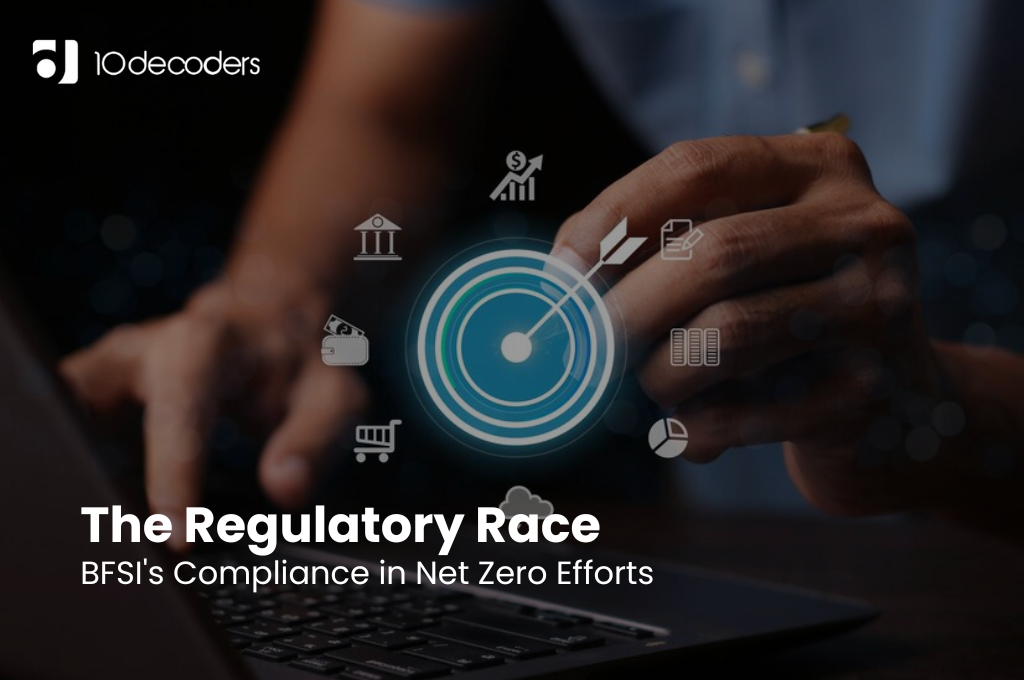The Regulatory Race: BFSI's Compliance in Net Zero Efforts
The global commitment to achieving net zero emissions by 2050 has sparked a transformative race across industries. Within the Banking, Financial Services and Insurance (BFSI) sector, navigating this transition presents both challenges and opportunities. While BFSI plays a crucial role in financing the shift towards a low-carbon economy, it must also adapt its own operations and offerings to comply with an evolving regulatory landscape. This blog delves into the key regulatory implications for BFSI in net zero initiatives.
Regulatory Landscape Evolution
The regulatory framework encompassing net zero goals is rapidly evolving, with various national and international bodies establishing their own mandates and timelines. Key regulatory bodies like the Network for Greening the Financial System (NGFS), the International Sustainability Standards Board (ISSB), and the Central Banks and Supervisors Network for Greening the Financial System (NGFS) are shaping the global landscape.
Emerging Regulatory Pillars
Several key pillars are shaping the regulatory landscape for BFSI in net zero efforts
- Climate-Related Financial Disclosures (TCFD): The Task Force on Climate-Related Financial Disclosures (TCFD) framework has become a global standard for reporting climate-related risks and opportunities. Regulatory bodies worldwide are increasingly mandating TCFD adoption, requiring BFSI institutions to disclose their climate risks, impacts, and transition plans.
- Taxonomy Frameworks: Governments and supranational bodies are developing taxonomies to classify economic activities as “green” or “sustainable.” These frameworks aim to guide financial institutions in directing investments towards sustainable projects and activities. The EU Taxonomy, for example, is already being implemented in member states and influencing investment decisions.
- Prudential Regulation: Central banks and financial regulators are implementing prudential measures to strengthen the resilience of the financial system against climate risks. These measures may include capital requirements, stress testing exercises, and supervisory tools to assess and manage climate-related financial risks.
- Consumer Protection: Regulators are also focusing on consumer protection in the context of green finance. This includes ensuring transparency in labelling financial products as “green” and preventing greenwashing practices.
BFSI's Compliance Challenges
Meeting these evolving regulatory requirements poses significant challenges for BFSI institutions. Key challenges include
- Data Availability and Quality: Accurately assessing and reporting climate-related risks requires robust data on emissions, energy consumption, and other sustainability metrics. However, data availability and quality in this domain remain limited.
- Methodological Inconsistencies: Different regulatory bodies and reporting frameworks may employ different methodologies for calculating and disclosing climate-related risks. This inconsistency can create operational complexities and challenges for comparability.
- Capacity Building: Integrating climate considerations into core business practices and decision-making processes requires expertise and specialised skills. Building internal capacity across the organisation is crucial for effective compliance.
Opportunities for BFSI
Despite the challenges, the transition to a net zero economy presents significant opportunities for the BFSI sector. These include
- New Market Opportunities: Financing the low-carbon transition will require significant investments in renewable energy, energy efficiency, and sustainable infrastructure. BFSI institutions can tap into these growing markets by developing innovative financial products and services that support sustainable projects.
- Risk Management: Effectively managing climate-related risks can enhance the long-term financial stability and resilience of BFSI institutions. Proactive adaptation can also mitigate potential reputational damage associated with unsustainable practices.
- Enhanced Brand Reputation: Demonstrating leadership in sustainability efforts can improve brand reputation and attract ESG-conscious investors and customers.
Charting the Course: Responsible Finance in the Net Zero Era
To navigate this complex regulatory terrain and capitalise on the opportunities presented by the net zero transition, BFSI institutions must adopt a proactive and strategic approach. Here are some key steps
- Embedding Sustainability into Core Strategies: Integrate ESG considerations into all aspects of business operations, from investment decisions and product development to risk management and corporate governance.
- Strengthening Data Infrastructure: Invest in robust data collection and analysis systems to track and measure environmental impact, assess climate-related risks, and inform decision-making.
- Enhancing Transparency and Disclosure: Proactively disclose ESG performance based on established frameworks and regulatory requirements, fostering stakeholder trust and confidence.
- Engaging in Collaborative Initiatives: Partner with other financial institutions, policymakers, and industry stakeholders to develop and implement effective climate finance solutions and best practices.
- Building Capacity and Expertise: Train employees on sustainability principles and equip them with the knowledge and skills to integrate ESG considerations into their daily work.
Conclusion
The BFSI sector plays a critical role in facilitating the transition to a net zero economy. Navigating the evolving regulatory landscape presents both challenges and opportunities. By actively engaging with regulators, embracing transparency, and developing innovative solutions, BFSI institutions can not only ensure compliance but also position themselves as leaders in a sustainable future. The regulatory race towards net zero has begun, and it is essential for BFSI to run with purpose and innovation to secure its place in this transformative journey.



